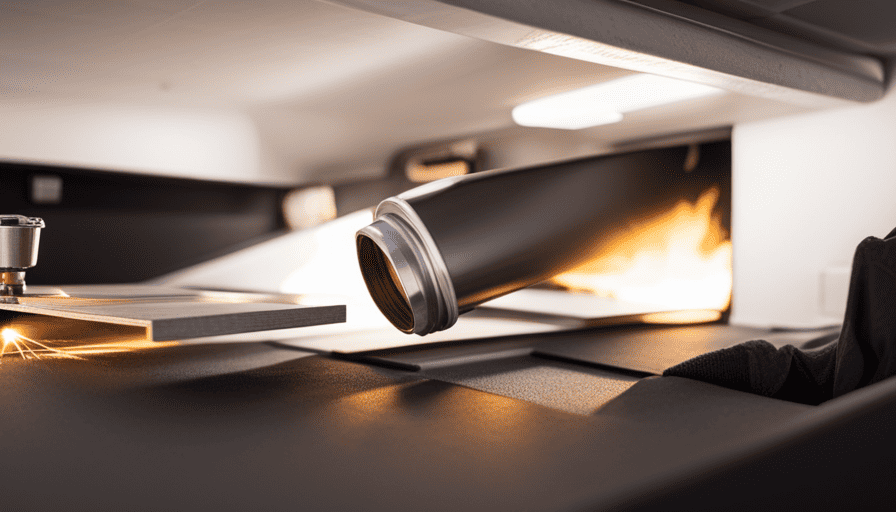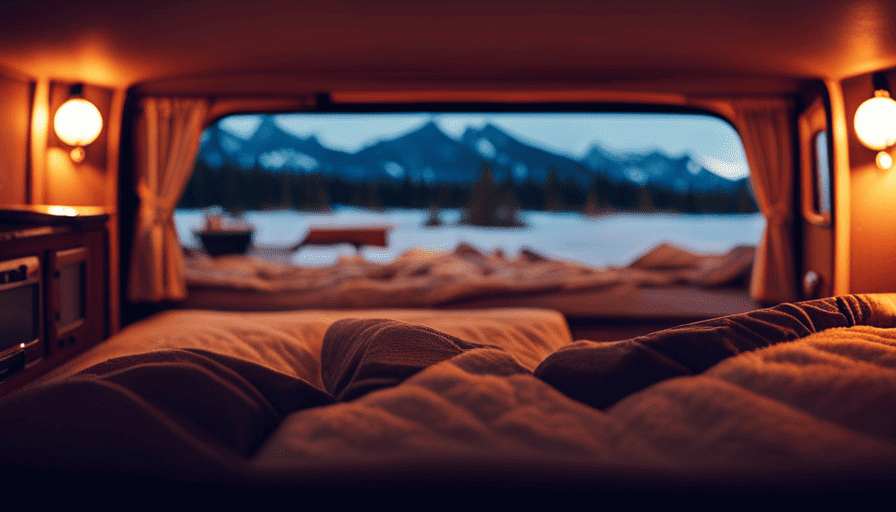Do you feel frustrated with limited space and lack of storage in your RV? If so, building an RV slide-out may be the solution you need.
In this article, I will guide you through the step-by-step process of constructing your own camper slide out, providing you with the technical knowledge and precise instructions you need to get started.
First and foremost, it is essential to determine the size and design of your slide out. This will ensure that it fits seamlessly with your existing camper layout. Once you have a plan in mind, gather all the necessary materials and tools, including a measuring tape, saw, screws, and a sliding mechanism.
Next, you will need to measure and cut the frame for your slide out, ensuring accuracy and precision. Assemble the frame and securely attach it to your camper, ensuring it is level and stable. Install the sliding mechanism, allowing for smooth and effortless operation.
Moving on, you’ll want to install windows and doors for ventilation and easy access. Adding insulation and wiring will provide comfort and functionality. Finally, finish the interior with flooring, walls, and furniture that suit your style and needs.
By following these detailed instructions, you’ll be able to build a camper slide out that maximizes space and enhances your camping experience. Get ready to enjoy the freedom of extra room and storage on your next adventure!
Key Takeaways
- Determining the size and design of the slide out is the first step.
- Gathering necessary materials and tools is essential.
- Accurate measurements and precise cutting are crucial for frame construction.
- Installing windows, doors, insulation, and wiring will provide ventilation, access, comfort, and functionality.
Determine the Size and Design of Your Camper Slide Out
So, you’re ready to start building your dream camper slide out, but first, let’s figure out the perfect size and design for your needs!
Determining the size and design of your camper slide out is crucial to ensure it meets your weight capacity requirements and incorporates necessary safety precautions. To begin, calculate the weight capacity your slide out needs to support. Consider the weight of the furniture, appliances, and occupants that will be using the slide out. This will help determine the dimensions and materials needed for construction.
Next, take into account any safety precautions that need to be considered. Ensure the slide out is securely attached to the camper frame and that it can withstand any lateral forces or movements when extended. Additionally, incorporate safety features such as handrails or non-slip surfaces to prevent accidents.
Once you have determined the size and design based on weight capacity and safety, you can move on to gathering the necessary materials and tools for construction.
Gather the Necessary Materials and Tools
First, gather all the materials and tools needed for constructing the slide-out feature for your camper. To ensure a smooth construction process, it’s essential to have the following tools on hand: a circular saw, a drill with various drill bits, a tape measure, a level, a pencil, a square, a clamp, and safety equipment such as goggles and gloves. These tools will help you accurately measure, cut, and assemble the materials for your slide-out.
When it comes to finding affordable materials, consider visiting local salvage yards or recycling centers, as they often have a variety of materials that can be repurposed for your camper slide-out. Additionally, online classifieds and forums can be excellent resources for finding used building materials at a lower cost.
In your search for materials, keep in mind that you’ll need sturdy and durable components such as plywood, aluminum or steel framing, heavy-duty drawer slides, screws, and adhesive. Prioritize materials that can withstand the weight and movement of the slide-out feature.
Once you’ve gathered all the necessary materials and tools, you can move on to the next step of the construction process: measuring and cutting the frame for your slide-out.
Measure and Cut the Frame for Your Slide Out
To create the foundation for your expanding dreams, take your measuring tape and let it dance across the sturdy materials, curving and bending to the rhythm of your vision, as you carefully mark the dimensions of the frame for your slide-out. Measuring accuracy is crucial at this stage, as any miscalculations can lead to a faulty slide-out that won’t fit properly. Ensure that your measurements are precise, using the appropriate measuring tools and techniques.
When cutting the frame, accuracy is paramount. A slight error in your cutting technique can result in uneven edges or misaligned joints, compromising the structural integrity of the slide-out. Take your time and use a sharp saw or cutting tool that’s suitable for the material you’re working with. Make clean, straight cuts, following your marked dimensions precisely.
Once you’ve measured and cut the frame, you’re ready to assemble it and secure it to your camper. This step will bring your slide-out closer to reality, transforming your camper into a more spacious and versatile living space.
Assemble the Frame and Secure it to Your Camper
Once you’ve measured and cut the frame, it’s time to put it all together and firmly attach it to your camper, bringing your expanded living space one step closer to reality.
The frame assembly is a crucial step in building a camper slide out, as it provides the structure and support necessary for the slide out to function properly. Start by aligning the cut pieces of the frame according to your measurements. Use screws or bolts to secure the corners and joints together, ensuring a tight and sturdy fit. Reinforce the frame by adding cross supports at regular intervals. These supports will prevent the frame from sagging or flexing under the weight of the slide out.
Once the frame is assembled, it’s time to secure it to your camper. Position the frame in the desired location, ensuring it is level and aligned with the camper’s walls. Use screws or bolts to attach the frame to the camper’s structure, making sure to penetrate into solid wood or metal for maximum strength. Consider using brackets or additional supports for added stability.
With the frame securely in place, you’re ready to move on to the next step of the process: installing the sliding mechanism. This mechanism allows the slide out to smoothly move in and out, providing the flexibility and convenience you desire.
Install the Sliding Mechanism
Now that you’ve securely assembled the frame, it’s time to take it to the next level and really maximize your living space by installing the sliding mechanism.
The sliding mechanism is a crucial component of your camper slide out as it allows you to extend and retract the slide out smoothly and effortlessly.
To install the sliding mechanism, start by positioning the mechanism on the frame, ensuring it’s centered and aligned properly. Secure it in place using bolts, making sure they’re tightened adequately to prevent any movement during operation.
Once the sliding mechanism is securely in place, it’s time to adjust it to ensure smooth operation. This involves checking the alignment of the mechanism and making any necessary adjustments. Keep in mind that the adjustments may vary depending on the specific sliding mechanism you’re using, so refer to the manufacturer’s instructions for guidance.
Troubleshooting common issues with the sliding mechanism is also an important step. Common issues may include sticking or jamming of the slide out. To troubleshoot these problems, inspect the mechanism for any obstructions or misalignments. Lubricate the moving parts with a suitable lubricant to reduce friction and ensure smooth operation.
With the sliding mechanism installed and adjusted, it’s time to move on to the next step: building the flooring and walls of your slide out. This will complete the structural assembly of your camper slide out, providing a sturdy and functional living space extension.
Build the Flooring and Walls of Your Slide Out
Ready to transform your living space and create a whole new level of comfort? Let’s dive into the exciting process of constructing the flooring and walls for your fantastic slide-out addition!
When it comes to choosing the right flooring materials for your camper slide-out, durability and ease of maintenance are key factors to consider. Opt for materials like vinyl or laminate flooring, as they’re not only resistant to moisture and stains but also provide a sleek and modern look. Additionally, make sure the flooring is sturdy and can support the weight of furniture and appliances.
For the construction of the walls, start by measuring and cutting the plywood panels according to the dimensions of your slide-out space. Attach the panels securely to the frame using screws or nails. To enhance insulation and soundproofing, consider adding a layer of foam insulation between the plywood panels before installation.
To make your slide-out even more functional, consider incorporating these sub-lists:
-
Flooring Materials:
- Vinyl flooring
- Laminate flooring
- Sturdy and supportive materials
-
Wall Construction:
- Measuring and cutting plywood panels
- Attaching panels securely
- Adding foam insulation for insulation and soundproofing
Now that your slide-out’s flooring and walls are complete, it’s time to install windows and doors for ventilation and easy access. This won’t only allow fresh air to circulate but also provide a convenient entry and exit point for your camper slide-out.
Install Windows and Doors for Ventilation and Access
To enhance the functionality and aesthetics of your cozy living space, it’s time to bring in the refreshing breeze and easy access with the installation of windows and doors. Ventilation is crucial in a camper slide out, as it helps to circulate air and prevent stuffiness. When choosing windows, consider options that can be easily opened and come with screens to keep bugs out. Additionally, installing a roof vent or a fan can provide additional airflow. For doors, opt for lightweight materials that are durable and easy to open and close.
When installing windows and doors, it’s important to follow proper techniques to ensure a secure fit. Start by measuring the dimensions of the openings and selecting windows and doors that match those measurements. Use sealant and weatherstripping to prevent leaks and drafts.
Incorporating a 3-column, 3-row table can provide a visual representation of the ventilation options and door installation tips.
| Ventilation Options | Door Installation Tips |
|---|---|
| Windows with screens for bug-free airflow | Choose lightweight and durable materials |
| Roof vent or fan for additional ventilation | Measure and select windows and doors that match dimensions |
| Sealant and weatherstripping to prevent leaks | Properly secure windows and doors for a secure fit |
To further enhance the comfort and functionality of your camper slide out, the next step is to add insulation and wiring. This will ensure a cozy living space and the ability to power essential appliances and devices.
Add Insulation and Wiring for Comfort and Functionality
Enhance your cozy living space by incorporating insulation and wiring, transforming your camper into a warm and functional haven. When it comes to insulation techniques, there are a few key considerations to keep in mind.
Firstly, ensure that all gaps and seams are properly sealed to prevent any drafts or heat loss. This can be achieved using insulation foam or tape.
Secondly, choose an insulation material that provides both thermal and sound insulation properties, such as fiberglass or foam board. Install the insulation material in the walls, ceiling, and floor of your camper, paying close attention to any areas that may be prone to condensation or moisture buildup.
Moving on to wiring best practices, safety should always be the top priority. Begin by carefully planning the layout of your electrical system, taking into account the location of appliances, outlets, and switches. Use high-quality wiring and connectors to ensure a reliable and safe electrical connection. Consider installing a fuse box or circuit breaker to protect your electrical system from overloading or short circuits. It’s also important to properly ground your electrical system to minimize the risk of electrical shock.
By incorporating these insulation techniques and wiring best practices, you can create a comfortable and functional living space in your camper. As you move on to the next section about finishing the interior with flooring, walls, and furniture, you’ll have a solid foundation to build upon.
Finish the Interior with Flooring, Walls, and Furniture
Transform your camper into a cozy haven by adding the perfect finishing touches with your choice of flooring, walls, and furniture. The interior design of your camper plays a crucial role in creating a comfortable and functional space.
Here are some key considerations to keep in mind when finishing the interior of your camper:
-
Flooring: Opt for durable and easy-to-clean materials such as vinyl or laminate flooring. Ensure that the flooring is properly installed and secured to withstand the movement of the camper.
-
Walls: Choose lightweight and moisture-resistant materials for the walls, such as plywood or fiberglass. Consider adding insulation to regulate temperature and reduce noise.
-
Furniture: Select furniture that’s compact, multifunctional, and lightweight. Consider the available space and the functionality you require. Strategically arrange the furniture to maximize space and create a comfortable layout.
-
Lighting: Install adequate lighting fixtures to ensure good visibility inside the camper. LED lights are energy-efficient and provide bright illumination.
-
Storage: Incorporate smart storage solutions to efficiently utilize space. Use overhead cabinets, under-bed storage, and foldable furniture to maximize storage options.
By carefully considering the interior design and furniture arrangement of your camper, you can create a comfortable and functional space that meets your needs.
Once the interior is complete, it’s time to test and adjust the slide out for smooth operation.
Test and Adjust the Slide Out for Smooth Operation
Once the interior is complete, it’s time to give the slide-out a test run and make any necessary adjustments for smooth and seamless operation, ensuring that it effortlessly extends and retracts with just a touch of a button. Did you know that approximately 80% of RV owners consider a slide-out to be a must-have feature in their camper?
To test and adjust the slide-out, follow these adjustment techniques and troubleshooting tips:
Adjustment Techniques:
- Start by checking the alignment of the slide-out. Ensure that it extends and retracts parallel to the camper’s body.
- Check the slide-out’s seals and gaskets for any gaps or damage. Replace if necessary to prevent water leakage.
- Lubricate the slide-out mechanism using a recommended lubricant to ensure smooth operation.
- Inspect the slide-out’s rollers, tracks, and gears for any signs of wear or damage. Replace any worn-out components.
- Test the slide-out’s operation multiple times to ensure it extends and retracts fully without any obstructions.
Troubleshooting Tips:
- If the slide-out is not extending or retracting smoothly, check for any debris or objects blocking its path.
- If the slide-out is making unusual noises, inspect the gears and rollers for any issues and lubricate them if needed.
- If the slide-out is misaligned, adjust the leveling jacks or stabilizers to ensure proper alignment.
By following these adjustment techniques and troubleshooting tips, you can ensure that your camper slide-out operates smoothly and seamlessly, enhancing your camping experience.
Frequently Asked Questions
How much weight can a camper slide out support?
The weight capacity of a camper slide out depends on several design considerations. Factors such as the type of materials used, the structural integrity of the slide out mechanism, and the overall weight distribution of the camper play a crucial role.
It is important to consult the manufacturer’s guidelines and specifications to determine the specific weight capacity of your camper slide out. Properly following these guidelines ensures safe and reliable operation of the slide out.
What is the average cost of building a camper slide out?
The average cost of building a camper slide out depends on various factors, such as the size, materials used, and complexity of the design. A basic camper slide out design can range from $1,000 to $3,000, while more custom and intricate installations can cost upwards of $5,000.
It’s important to consider the cost of materials, labor, and any additional features you may want, such as electrical components or insulation.
Are there any safety precautions to consider when using a camper slide out?
When using a camper slide out, it’s important to consider safety precautions. To ensure the safety of users, manufacturers incorporate various safety features into the installation process. These may include sturdy locks to prevent accidental movement, reinforced brackets for stability, and sensors to detect obstructions.
Additionally, it’s crucial to follow the manufacturer’s instructions carefully and regularly inspect the slide out for any signs of wear or damage. By prioritizing safety, you can enjoy the convenience of a camper slide out with peace of mind.
Can a camper slide out be added to any type of camper?
Adding a camper slide out can greatly enhance your camping experience by expanding your living space. The benefits of camper slide outs are numerous. They provide extra room for dining, lounging, and sleeping, making your camper feel more spacious and comfortable. Additionally, slide outs allow for better organization and storage options.
However, it’s important to note that not all campers are compatible with slide outs. It’s crucial to consult with a professional to determine if your camper can accommodate this feature.
Are there any maintenance tips for keeping a camper slide out in good working condition?
To keep a camper slide out in good working condition, it’s crucial to follow a regular maintenance schedule.
Inspect the slide out mechanism for any signs of wear or damage, and lubricate the moving parts as recommended by the manufacturer.
Common slide out problems include misalignment, leaks, and motor issues. These can be prevented by keeping the slide out clean, checking the seals regularly, and addressing any issues promptly.
Can I Incorporate a Slide Out into my Lightweight Truck Camper Shell?
Yes, it is indeed possible to incorporate a slide out into a build lightweight truck camper shell. This feature can provide more living space, making your camper experience more comfortable and convenient. By adding a slide out, you can maximize the available area inside your camper shell, allowing for additional amenities and room to move around.
Conclusion
In conclusion, building a camper slide out requires careful planning, precise measurements, and the right materials and tools. It’s a technical and detailed process, but the end result can greatly enhance the functionality and comfort of your camper.
One interesting statistic to emphasize the importance of a well-designed slide out is that campers with slide outs have been shown to increase the living space by up to 30%, providing more room for relaxation and activities during your camping trips.










